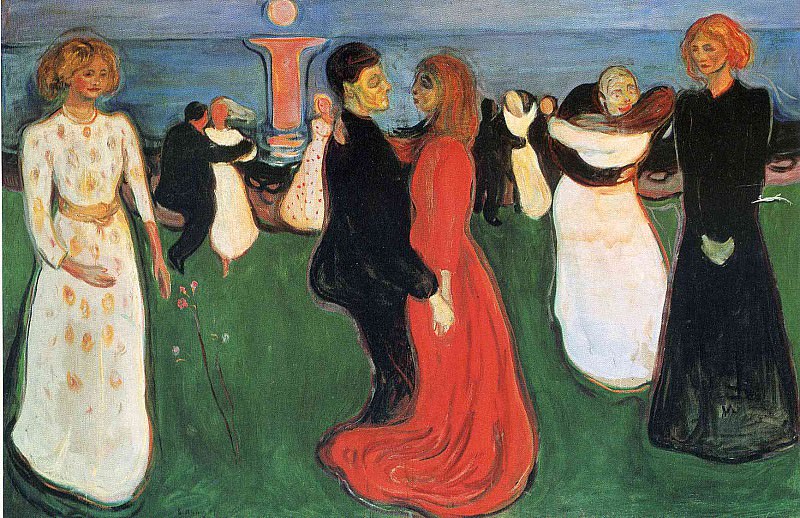Life dance Edvard Munch (1863-1944)
Edvard Munch – Life dance
Edit attribution
Download full size: 1734×1122 px (0,2 Mb)
Painter: Edvard Munch
The Norwegian painter played a major role in German Expressionism. In his art he tried to explain life and its meaning. His subtle visions of the soul and the human being can only be understood intuitively. Munch’s painting depicts men and women. Some couples merge in a dance. At the edges of the painting, however, stand lonely women. On the left is a woman in a white dress dancing. Her eyes are downcast.
Description of Edvard Munch’s painting The Dance of Life
The Norwegian painter played a major role in German Expressionism. In his art he tried to explain life and its meaning. His subtle visions of the soul and the human being can only be understood intuitively.
Munch’s painting depicts men and women. Some couples merge in a dance. At the edges of the painting, however, stand lonely women. On the left is a woman in a white dress dancing. Her eyes are downcast. She is probably sad that she is without a date at this ball. She symbolizes innocence, purity, and chastity.
On the left is the woman in the black dress. Her hands are intertwined and downcast. The gaze is blank and a little frightening.
In the foreground, the dancing couple of a man and a woman stand out vividly. More visible are the outlines of people than any traced details. It is noticeable that the girl has one hand on the shoulder of the young man, and she is holding her partner’s hand with the other. They are dancing, tightly pressed against each other. The man is likely to be in a classic black suit, while the girl is wearing a bright red floor-length dress. It usually symbolizes beauty and love. In their dance, one can feel complete dedication, openness and lightness.
There are several interpretations of this painting. The painting describes the different states of a woman. On the left is innocence and simplicity in the form of a woman in white. Then young and youthful period, where the girl is coquettishly dancing with her partner. On the right is maturity, already devoid of any hope.
According to another version, the emphasis is on the dancing couples. The couple on the left represents youth, i.e., they have just entered adulthood. There are no responsibilities before them, they just feel good about being with each other. In the center is the mature couple. Their dance is full of unhurriedness and thoroughness. They are already capable of emotional and intellectual support for each other and soberly assess themselves and their partner. The older couple is on the right. They are no longer as active, but they are seasoned. These three couples show the past, present, and future.
Кому понравилось
Пожалуйста, подождите
На эту операцию может потребоваться несколько секунд.
Информация появится в новом окне,
если открытие новых окон не запрещено в настройках вашего браузера.
You need to login
Для работы с коллекциями – пожалуйста, войдите в аккаунт (open in new window).




















COMMENTS: 1 Ответы
Прекрасная, эмоциональная работа мастера, в которой Э. Мунк, показывает – местного жиголо, который выбрал сам себе даму, причем не потому, что она ему больше нравится, а потому, что его любят – другие женщины. Эта тема – будет продолжена в знаменитой работе художника "Пепел", в которой Господь прекращает страдания художника, и дарит ему любовь, посадив в сердце росток счастья, которое начинает цвести, как молодое дерево, в сердце художника. И, дама в которую влюбился Мунк – отвечает ему взаимностью. Но он, отвергает любовь, и начинает страдать, а цветущее дерево в сердце художника, превращается в пепел, как догоревшая свеча. И он скорбит над потерянным счастьем, и снова пишет на холсте свои муки, превратившиеся в пепел, сгоревшего дерева...
You cannot comment Why?